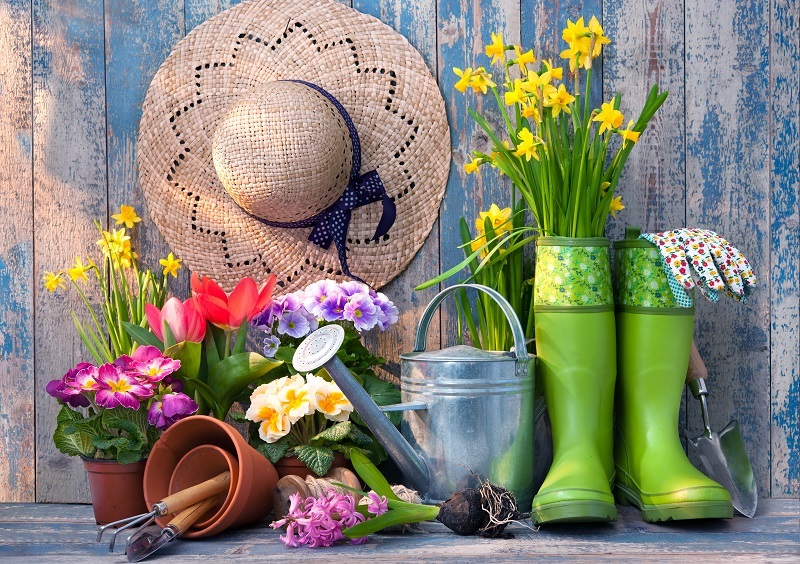12 Flowers that Will Thrive Season After Season
Posted on 13/08/2025
12 Flowers that Will Thrive Season After Season
Are you searching for flowers that will thrive season after season in your garden? Whether you're a seasoned gardener or just starting, choosing the right perennial flowers is essential for a garden that blooms year after year with minimal fuss. Perennial plants return after each winter, offering cost-effective and reliable color to your landscape. In this comprehensive guide, we'll explore 12 spectacular flowers that flourish repeatedly, transforming your outdoor space into a vibrant haven season after season.

Why Choose Flowers that Recur Each Year?
- Low Maintenance: Perennial flowers require less work than replanting annuals every year.
- Cost Effective: Invest once and enjoy years of blooms, saving money over time.
- Eco-Friendly: Established root systems prevent soil erosion and support local wildlife.
- Continuous Garden Beauty: Creates a consistently lush and colorful garden each season.
If you dream of a flourishing landscape, choosing flowers that will thrive season after season is the key. Let's dive into the top perennial flowers that promise repeat performances, year after year.
1. Coneflower (Echinacea)
Coneflowers are garden staples known for their resilience and long-lasting beauty. These perennial blooms come in shades of purple, pink, yellow, and white. They're drought-tolerant, attract pollinators, and are resistant to most pests. Echinacea thrives in full sun and well-draining soil, making it a versatile choice for most gardens.
Why They'll Thrive Season After Season:
- Survive challenging weather conditions and drought
- Return reliably every summer
- Ideal for sunny flower beds and wildflower gardens
2. Daylily (Hemerocallis)
Known as one of the easiest flowers to grow, daylilies adapt to a wide range of soils and climates. Their spectacular, trumpet-shaped flowers open for a single day, but each plant produces multitudes of blooms throughout the season. Their foliage remains attractive even after the blooms fade.
Main Features:
- Repeat-blooming varieties extend the display for months
- Available in nearly every color
- Tolerant of neglect and poor soils
3. Black-Eyed Susan (Rudbeckia hirta)
The sunny yellow petals and dark centers of Black-Eyed Susans are unmistakable. These native perennials are drought-resistant, easy to care for, and contribute to late summer and fall color. Butterflies adore them, and their rugged constitution means they're likely to come back stronger each year.
4. Lavender (Lavandula)
Want fragrance and beauty? Lavender is a tough perennial that delivers year after year. Thriving in full sun and sandy, well-drained soil, it's perfect for borders, cottage gardens, and even containers. Lavender's silver-green foliage and purple spikes attract bees and are prized for their calming aroma.
Benefits of Growing Lavender Annually:
- Deer and rabbit resistant
- Excellent for pollinator gardens
- Produces harvestable fragrant blooms
5. Peony (Paeonia)
Peonies are renowned for their enormous, luxurious blossoms and rich fragrance. Even better, these tough perennials have lifespans spanning decades--some peony plants mature into garden treasures that thrive for 50 years or more!
Why Peonies Stand Out:
- Long-lived and cold-hardy
- Stunning blooms in late spring to early summer
- Excellent cut flower for arrangements
6. Salvia (Salvia nemorosa)
Salvia is a must-have perennial flower for gardens seeking vibrant color and low-maintenance appeal. From deep blues to shimmering purples and pinks, Salvias provide vertical interest and rebloom multiple times throughout the growing season.
- Attracts hummingbirds and bees
- Drought-tolerant once established
- Works well in both containers and garden beds
7. Shasta Daisy (Leucanthemum x superbum)
Shasta daisies brighten up any landscape with their cheerful white petals and yellow centers. This classic garden plant returns every summer, often forming clumps that spread to create a lovely carpet of blooms.
- Easy to divide and propagate
- Long bloom period from early summer to fall
- Ideal for border plantings
8. Coreopsis (Coreopsis spp.)
Also known as tickseed, Coreopsis is a top choice for anyone seeking flowers that will thrive year after year. The daisy-like blooms appear in bright yellow, orange, and pink, providing a continual splash of color with minimal attention.
Advantages:
- Tolerant of dry and poor soils
- Suited to mass plantings and wildflower gardens
- Prolific self-seeder for naturalized landscapes
9. Bleeding Heart (Dicentra spectabilis)
Bring dramatic flair to your shade garden with the elegant bleeding heart. Unmistakable heart-shaped pink and white flowers dangle delicately from arching stems each spring. Though the foliage fades in summer, this perennial never disappoints when it returns the next year.
- Thrives in partial to full shade
- Perfect paired with hostas and ferns
- Low maintenance once established
10. Russian Sage (Perovskia atriplicifolia)
If you want reliable, drought-tolerant beauty, Russian Sage is a standout perennial. Silvery foliage is topped with spires of lavender-blue flowers from midsummer to fall. It's a top performer in hot, sunny borders or xeriscapes.
Key Attributes:
- Highly deer and pest resistant
- Drought-proof and thrives in poor soil
- Long bloom period with minimal care
11. Sedum / Stonecrop (Sedum spp.)
Succulent sedums are among the easiest perennials to grow. Their fleshy foliage comes in strawberry, green, burgundy, or blue-green. In late summer, star-shaped flower clusters attract bees and butterflies. Sedums are ideal for rock gardens and borders due to their drought tolerance.
- Minimal water needs
- Excellent for pollinator-friendly landscapes
- Varieties for both low-growing ground cover and upright accents
12. Astilbe (Astilbe spp.)
Astilbe's feathery plumes and fern-like foliage add soft texture and color to shady gardens. This long-lived perennial thrives in moist, well-drained soil and is available in hues from white and pink to red and lavender.
Main Benefits:
- Tolerant of shade and damp locations
- Beautiful, airy flower clusters from late spring through summer
- Easy to divide and multiply over the years
Essential Tips for Perennial Flower Success
To ensure your flowers thrive season after season, practice these key horticultural strategies:
- Choose the right varieties--select plants matched to your USDA Hardiness Zone and garden conditions.
- Invest in soil preparation; enrich with compost and ensure good drainage.
- Mulch annually to preserve moisture and suppress weeds.
- Divide perennials every 3-5 years to refresh their vigor and increase your plant supply.
- Deadhead spent blooms to stimulate fresh flowering and keep plants tidy.
Frequently Asked Questions (FAQs)
Can I grow perennial flowers from seed?
Yes! Many perennials, like Black-Eyed Susan, Coneflower, and Coreopsis, are easily started from seed. While flowering can take an extra year compared to nursery plants, it's a cost-effective way to fill your garden with season-sustaining flowers.
How do I protect my perennials in winter?
Most perennial flowers require little care but appreciate a layer of mulch after frost to insulate roots. Avoid heavy pruning until spring; their dried stems can provide habitat for beneficial insects.
Which flowers for year-after-year blooming are deer resistant?
Try lavender, russian sage, and sedum. These are among the flowers that will come back each season and are rarely bothered by deer.
Are there perennial flowers for shade?
Absolutely. Astilbe and Bleeding Heart thrive in partial to full shade and return reliably every year.

Conclusion: Colorful Gardens, Year After Year
Filling your landscape with flowers that will thrive season after season is one of the best ways to create a beautiful, low-maintenance, and eco-friendly garden. Whether you desire robust foliage and vibrant blooms for your sunniest border, or a graceful palette for a shady retreat, the perennials listed above offer reliable performance for years to come.
By planning and planting a mix of these tough, resilient flowers, you guarantee a tapestry of colors and textures that enrich your garden season after season--delighting both you and your local pollinators. Start small, or go bold, and discover just how rewarding sustainable gardening can be!
Related Resources
- Guide to choosing perennials for sun or shade
- How to improve your garden's soil
- More perennial flower combinations for all seasons
Latest Posts
Expert Tips to Keep Your Poinsettias Vibrant Longer
Secrets to Thriving Hydrangeas
Unveiling the Hidden Meanings of Peony Flower Colours





